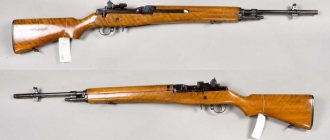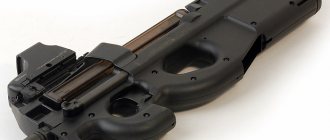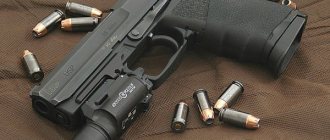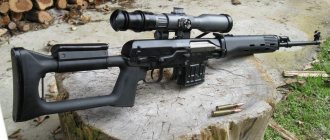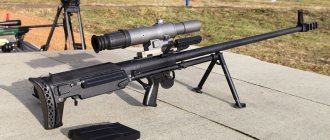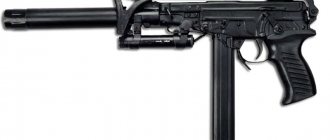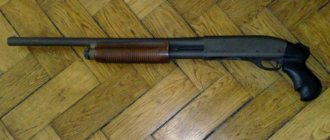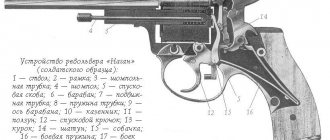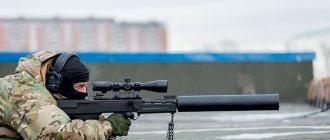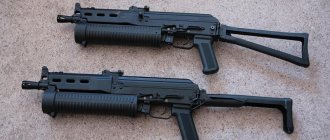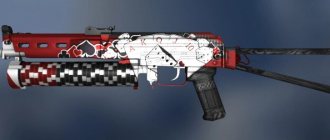If we discard the political point of view, then the world in the second half of the 20th century can be called tripolar: while some were shooting from, and others were mastering the M-16, still others were holding a Belgian machine gun in their hands. Before starting a debate about the qualitative superiority of this or that system, let’s pay attention to the least known competitor - weapons from FN Herstal.
FN FAL assault rifle
The history of the creation of the FN FAL assault rifle
The entire class of assault rifles begins with the Sturmgewehr 44 - the first relatively successful attempt by the Third Reich to develop, first of all, ammunition that would meet the new conditions of military operations, and only then a weapon capable of unleashing the potential of the new cartridge. Readers from the countries of the former Soviet Union are more accustomed to calling such samples “automatic machines.” Despite the different names, in both cases we are talking about automatic weapons using intermediate cartridges. Due to the deplorable situation of the German army and industry in 1944, new weapons were produced in limited quantities, although they proved their viability.
After the defeat of Germany and Churchill's Fulton speech, the recent allies begin to qualitatively and quantitatively increase their arsenals, preparing for an even larger-scale war. The idea sown by German gunsmiths was positively noted by the generals of most countries and developments in the unoccupied niche are actively beginning. The prototype we are discussing begins to be developed by the Belgian company FN Herstal in 1946. History has preserved the names of the main developers - these are Dieudonné Sève and Ernest Vervier.
The main reason for such a long development was the controversy over the caliber used. The chief designers initially insisted on the 7.92*33 mm, already invented by the Germans, and in parallel, samples are being developed for existing rifle cartridges. Later, experiments began with the new .280 British, which can already be called relatively successful.
But the military doctrine of the newly created alliance of capitalist countries assumed the unification of ammunition among all allied countries, so the Americans largely imposed the standard of the 7.62 * 51 mm cartridge they invented. Indeed, the result was a very high-quality cartridge-weapon complex, but ironically, it was never adopted into service in the States itself, losing out to the M14.
The original model, judging by the plastic parts, was made around the 60s
Result
Work on the FN FAL weapon was completed in 1953. The rifle unit was completely ready for mass production. The first state to adopt the FN FAL rifle in 1955 was Canada. There the weapon was listed as C1. In Belgium, soldiers received this rifle model in 1956. A year later, FN FAL rifles were delivered to England. There, the Belgian-made weapon was listed as L1 SLR. Rifles in Austria since 1958. There they were renamed Sturmgewehr 58.
In accordance with NATO standards, the FN FAL weapon contains a muzzle brake and uses standard rifle grenades.
Design Features
One of the main advantages of the resulting assault rifle is ease of maintenance and use.
Main components:
- Receiver with the barrel itself and sights;
- Bolt carrier with bolt;
- Trigger mechanism;
- Gas piston in gas outlet tube;
- Return spring system;
- Receiver cover4
- Reloading handle;
- Stock, pistol grip and fire controls;
- Shop;
- A stock divided into a fore-end and a butt.
In different models, the butt can be fixed or folding, in connection with this the automation may change slightly - models with a “monolithic” butt contain a return spring, while in others the same spring is located in the receiver. Early FN FAL assault rifles had wooden fittings, which were later abandoned in favor of higher quality and more economical to produce plastic.
Detailed diagram of complete disassembly
Device
The design of the FN FAL is based on the same basic principles as the FN-49. Automation uses the energy of exhausted powder gases, and the amount of gas can be changed using a regulator. The regulator has seven positions on “metric” rifles and 11 on “inch” rifles. The barrel is locked by tilting the bolt downwards.
The ease of incomplete disassembly of the rifle is noteworthy. To do this, you need to press the latch lever, “break” the receiver, remove the top cover and pull out the bolt. The return spring on the basic version is located in the butt; on models with a folding stock, it was moved under the receiver cover.
The sight is diopter, with an adjustable rear sight.
On models with a folding stock, a flip rear sight was used. The use of optical sights was not initially envisaged, but soon after the start of production in Belgium they developed an option with a 3.6x optical sight mounted on a reinforced receiver cover.
In Britain, the 4x SUIT sight with a prism wrapping system was widely used; in Germany and Argentina, a 4x sight from Hensoldt was used. Finally, a sight made by Leitz was used in Canada and Australia, and the Canadians rated this FAL higher than the Lee-Enfield sniper rifle.
Various early versions of rifles were equipped with flame arresters of various designs, and to shoot rifle grenades it was necessary to wear a mortar. Since 1965, they began to use flame arresters with a standard diameter of 22 mm, adapted to launch grenades directly from them.
The bayonet was originally attached to a lug on the barrel; after the standardization of flash suppressors, a bayonet was developed that fits over the flash suppressor.
The installation of under-barrel grenade launchers was not intended, but in Vietnam, Australian special forces used the L1A1 with experimental American XM148 grenade launchers.
Principle of operation
A similar principle of automatic operation was previously encountered in the Soviet SVT-40 - this is the removal of powder gases with a short piston stroke. A gas outlet tube with a piston and its own spring is located above the barrel and is equipped with a regulator that allows you to adjust the gas outlet or completely block it for firing a rifle grenade.
The barrel bore is locked by a longitudinally sliding bolt vertically; the movement of the bolt frame is imparted by a gas piston at the moment of recoil. Depending on the stock layout, the return spring either communicates directly with the bolt carrier (in models with a folding stock) or through a tang.
The trigger mechanism is made as a separate unit and includes, in addition to the trigger itself, a pistol grip and a butt plate of the receiver. It is attached by a hinge method to the bottom of the receiver, slightly behind the magazine. It has its own mainspring. The safety, also known as the fire mode translator, is located above the handle on the left and has three modes: blocking fire, firing single shots, and automatic fire.
Detachable box magazines are used for ammunition supply. Interestingly, the British version of the assault rifle has its own model of magazines that cannot be installed in assault rifles from other manufacturers, but this principle does not work in the opposite direction.
Assault rifles from different manufacturers may have significant differences in the design of their sights. As a rule, they consist of a front sight on the front of the receiver and a diopter rear sight.
Mark on history
In general, the FN FAL enjoyed deserved popularity among soldiers and was considered a reliable and unpretentious weapon. The exception is Israel, where Romat rifles still failed to gain recognition and were assessed as very sensitive to dirt. It is significant that the British, based on their experience of using FN FAL in the sand (in Oman), changed the lubricant formulation and began making special grooves on the bolt stem.
Such modifications were not made in Israel.
The weapon initially received the nickname “hand of the free world” due to its prevalence. But in later times, after the growing popularity of the war in Rhodesia, as a symbol of the heroic resistance of a democratic civilization to tribalism and cave socialism, this epithet began to acquire a more “romantic” meaning. By the way, FN FAL also took part in other African wars of independence.
Ammunition for the FN FAL assault rifle
As mentioned above, the 7.62*51 mm NATO cartridge was chosen as the base cartridge.
The basic cartridge has the following parameters:
- Initial bullet speed – 840 m/s;
- The initial energy of the bullet is 3600 J.
Now let's look at the existing varieties:
| Marking | Note |
| M59 | One of the most common types, a bullet with a steel core |
| M61 | Armor-piercing ammunition |
| M62 | Tracer ammunition |
| M80 | Cartridge with full metal jacketed bullet |
| M118 | Specialized ammunition for snipers |
| M198 | Cartridge with two bullets |
| M993 | A later version of the armor-piercing cartridge |
| .308 Winchester | Sales designation for hunting and sport shooting purposes |
Due to the peculiarities of the names and possible confusion in the indexes, this list does not claim to be complete. However, based on what we saw, there is no doubt about the further use of cartridges of this caliber in the arms industry.
They are even made in Russia!
About sights
According to experts, different modifications of the FN FAL are equipped with different aiming tools. Most models have a diopter rear sight. In addition, the front sight is traditionally located in front of the gas outlet device. In the original shooting model, the sighting devices are designed for distances within 200-600 m. In order to make the rifle effective in a wide variety of conditions, the Belgian developers equipped the front sight of the weapon with a special backlight, which is a luminous point.
Rifle Specifications
Characteristics refer to the original model:
| Length | 1090 mm |
| Barrel length | 533 mm |
| Weight without cartridges | 4.45 kg |
| Rate of fire | 650-700 rounds per minute |
| Sighting range | 650 m |
| Effective range | 500 m |
| Magazine capacity | 20 or 30 rounds |
Such a small value of the sighting range is determined by the excess power of the cartridge together with the relatively low weight of the rifle - when firing in bursts, the barrel inevitably “goes” upward, regardless of the shooter’s training.
Advantages and disadvantages
The FN FAL rifle has become one of the most recognizable symbols of the Cold War, and is still firmly in the first cohort.
Advantages:
- Enormous lethality against both unprotected manpower and enemies in body armor, and when using armor-piercing cartridges, against more difficult-to-reach targets;
- The cartridge's stable ballistics showed itself especially well in the jungle during the Vietnam War and during punitive operations against South American drug cartels. Where 5.56 mm machine gun shots were “lost” in dense vegetation, the larger bullet did not stray from its trajectory;
- Easy to care and maintain. Now a soldier can literally “in the trench” partially disassemble a weapon for cleaning and lubrication, although this is not recommended;
- Huge potential for modification.
But nothing is perfect - the assault rifle has a number of disadvantages:
- Inability to conduct targeted burst fire due to excessive recoil;
- FN FAL looks too large compared to other assault rifles of that time;
- Although vulnerability to dirt and dust can be easily corrected with regular maintenance, it remains a disadvantage.
The humorous title of “the right hand of the free world” was assigned to the FN FAL due to its widespread distribution in the NATO bloc. In its “finest hour” it was adopted into service in more than 90 countries around the world.
Combat use
The FN FAL's combat career turned out to be closely connected with counter-guerrilla operations. But, of course, not only with them. British and Commonwealth armies fought against her in Malaya, Oman, Indonesia, Vietnam and the Falklands. And special forces, who did not trust the new L85 assault rifle, took the FAL with them during Desert Storm. The fight against Ulster terrorists during periods of their activity was not without the L1A1.
Rifle L1A1
During the Arab-Israeli wars of 1967 and 1973. The Romat was the main weapon of the Israeli infantry. And Indian 1A1s were used in the war with Pakistan. A particularly striking page in history, written with the participation of FN FAL, was the war for “independent Africa”. The mercenaries who fought on the side of Moise Tshombe in Katanga were armed with Belgian weapons. The L1A1 was used by Colonel Ojukwu's fighters in Biafra.
Until the 80s, R1 assault rifles were used by South African forces in border wars with Angola. Finally, the FN FAL of various variants was the main weapon of the Rhodesian troops. Rifles were also used in various conflicts with rebels in South America. Interestingly, although FN FAL is not associated with socialist countries, it was the one preferred by the leader of the Cuban revolution, Fidel Castro.
